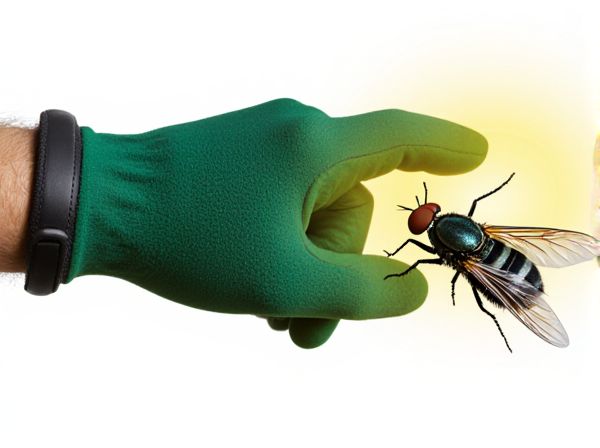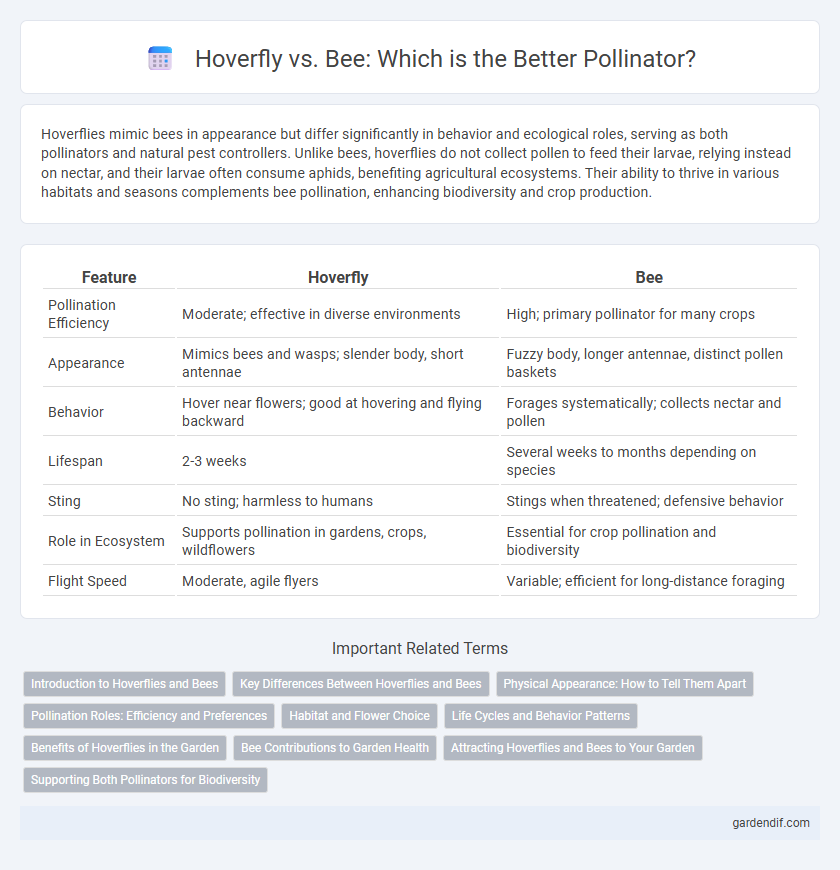
Hoverfly vs Bee Illustration
Hoverflies mimic bees in appearance but differ significantly in behavior and ecological roles, serving as both pollinators and natural pest controllers. Unlike bees, hoverflies do not collect pollen to feed their larvae, relying instead on nectar, and their larvae often consume aphids, benefiting agricultural ecosystems. Their ability to thrive in various habitats and seasons complements bee pollination, enhancing biodiversity and crop production.
Table of Comparison
| Feature | Hoverfly | Bee |
|---|---|---|
| Pollination Efficiency | Moderate; effective in diverse environments | High; primary pollinator for many crops |
| Appearance | Mimics bees and wasps; slender body, short antennae | Fuzzy body, longer antennae, distinct pollen baskets |
| Behavior | Hover near flowers; good at hovering and flying backward | Forages systematically; collects nectar and pollen |
| Lifespan | 2-3 weeks | Several weeks to months depending on species |
| Sting | No sting; harmless to humans | Stings when threatened; defensive behavior |
| Role in Ecosystem | Supports pollination in gardens, crops, wildflowers | Essential for crop pollination and biodiversity |
| Flight Speed | Moderate, agile flyers | Variable; efficient for long-distance foraging |
Introduction to Hoverflies and Bees
Hoverflies (family Syrphidae) and bees (family Apidae) are key pollinators essential for ecosystem stability and agricultural productivity. Hoverflies often mimic bees in appearance but can be distinguished by their single pair of wings and hovering flight, while bees possess two pairs of wings and are covered in branched hairs aiding pollen collection. Both contribute significantly to pollination, with bees handling a wider range of flowering plants and hoverflies excelling in pollinating certain crops and wildflowers.
Key Differences Between Hoverflies and Bees
Hoverflies and bees differ primarily in their physical characteristics and pollination roles; hoverflies possess large eyes and a single pair of wings, unlike bees which have two pairs of wings and hairy bodies adapted for pollen collection. Hoverflies mimic bees in appearance but lack stingers and typically feed on nectar without gathering pollen actively. In pollination efficiency, bees remain superior due to their specialized body hairs that trap and transfer pollen effectively across flowering plants.
Physical Appearance: How to Tell Them Apart
Hoverflies can be distinguished from bees by their slender bodies, large eyes, and lack of hairy thoraxes, unlike bees which have robust, hairy bodies adapted for pollen collection. Hoverflies often have bright yellow and black markings that mimic bees but possess only two wings, whereas bees have four wings. Their flight pattern is also different, with hoverflies capable of hovering in place, while bees exhibit more direct, purposeful flight.
Pollination Roles: Efficiency and Preferences
Hoverflies and bees both play crucial roles in pollination, but bees are generally more efficient due to their specialized body structures that enhance pollen transfer. Hoverflies prefer open, easily accessible flowers and often visit a wider variety of plants, complementing the pollination spectrum that bees cover. This difference in flower preferences and pollination efficiency highlights the importance of both insects in maintaining diverse and resilient ecosystems.
Habitat and Flower Choice
Hoverflies commonly inhabit a variety of environments, including gardens, meadows, and wetlands, thriving where their larval food sources like aphids are abundant. They prefer flowers with open, accessible nectaries such as umbellifers and composites, enabling easy feeding with their short mouthparts. Bees, including honeybees and bumblebees, are often found in diverse habitats from woodlands to agricultural fields and favor a wider range of flower shapes with rich nectar and pollen, especially tubular and bell-shaped blossoms.
Life Cycles and Behavior Patterns
Hoverflies have a complete metamorphosis lifecycle including egg, larva, pupa, and adult stages, with larvae often predating aphids, contrasting with bees that undergo complete metamorphosis but primarily focus on nectar and pollen collection throughout their adult phase. Behavioral patterns of hoverflies include mimicking bees or wasps as a defense mechanism, and adults frequently visit a diverse array of flowers for nectar, aiding pollination. Bees exhibit complex social structures in species like honeybees with division of labor, while solitary bees display varied nesting behaviors, both contributing significantly to pollination efficiency.
Benefits of Hoverflies in the Garden
Hoverflies contribute significantly to garden health by efficiently pollinating a wide range of flowers, often complementing bee activity due to their ability to thrive in cooler, cloudier conditions. Their larvae consume aphids and other garden pests, providing natural pest control that reduces the need for chemical interventions. Hoverflies also attract fewer predators, ensuring steady pollination services and enhancing biodiversity within garden ecosystems.
Bee Contributions to Garden Health
Bees play a vital role in garden health by efficiently pollinating a wide variety of plants, ensuring robust fruit and vegetable production. Their fuzzy bodies collect and transfer pollen between flowers more effectively than hoverflies, which contributes to greater seed set and biodiversity. The presence of bee populations in gardens supports ecosystem stability and enhances the yield and quality of crops.
Attracting Hoverflies and Bees to Your Garden
Hoverflies and bees both play crucial roles as pollinators, but attracting hoverflies requires planting a diverse range of nectar-rich flowers such as umbellifers, alyssum, and marigolds to provide abundant pollen and nectar. Bees are drawn to brightly colored flowers like sunflowers, lavender, and coneflowers that offer high-quality nectar and pollen sources, supporting their colony health. Creating a habitat with varied flowering plants that bloom at different times ensures continuous food supply for hoverflies and bees, boosting pollination efficiency in your garden.
Supporting Both Pollinators for Biodiversity
Hoverflies and bees play crucial roles in pollination, contributing to ecosystem biodiversity by supporting a variety of flowering plants. While bees are effective pollen carriers with specialized body structures, hoverflies complement this by visiting flowers that bees may overlook and providing pest control through their larvae. Encouraging habitats that support both hoverflies and bees enhances pollination efficiency and promotes resilience in agricultural and natural ecosystems.
Hoverfly vs Bee Infographic

 gardendif.com
gardendif.com